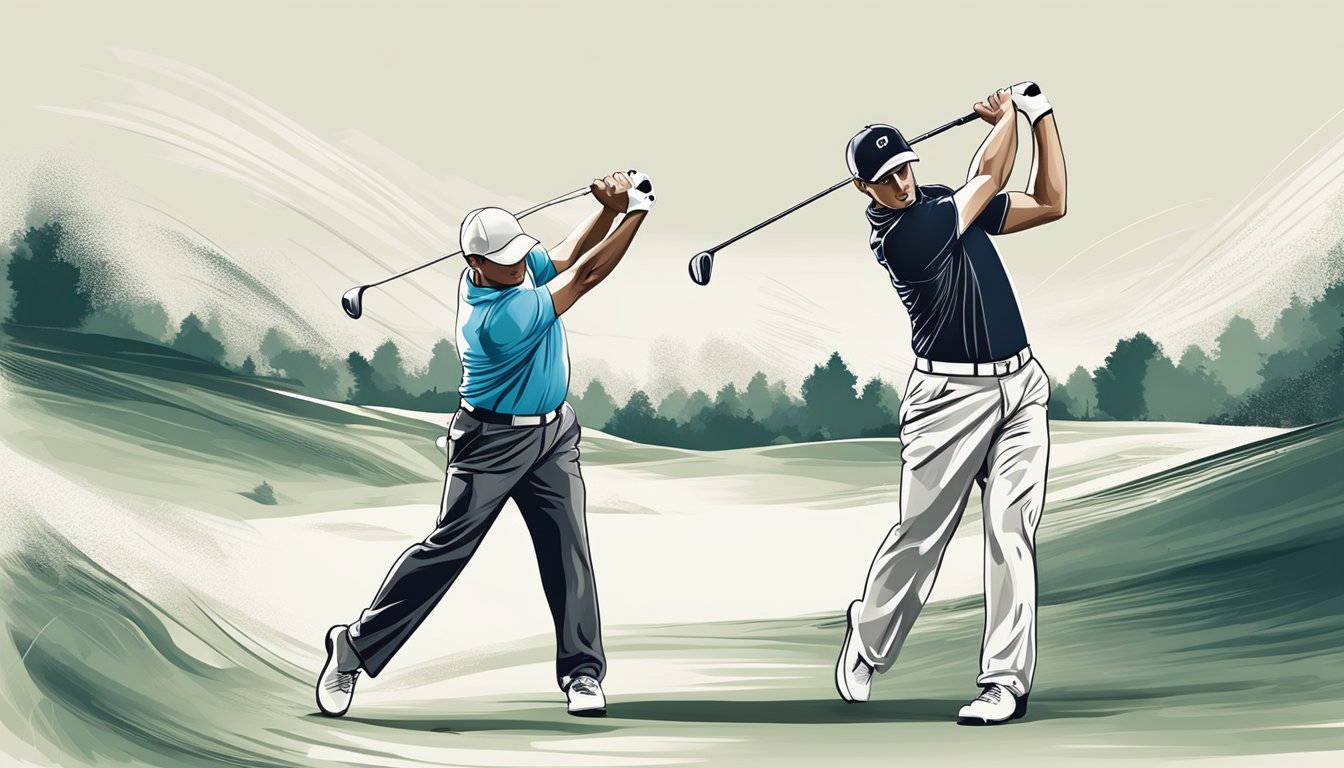If you’re a golfer looking to improve your game, you might have heard of the single plane golf swing. This technique, popularized by golf instructor Jim Hardy, involves keeping your arms and shoulders on the same plane throughout your swing. In contrast, a traditional golf swing involves a plane shift during the backswing and downswing.


Understanding the Single Plane Golf Swing
The single plane golf swing is based on the idea that keeping your arms and shoulders on the same plane can make your swing more consistent and easier to repeat. By eliminating the plane shift, you can simplify your swing and reduce the number of variables that can affect your ball flight. This can make it easier to hit straighter shots and improve your accuracy.
The Mechanics of a Single Plane Swing
To execute a single plane golf swing, you’ll need to focus on keeping your arms and shoulders on the same plane throughout your swing. This means that your left arm (for right-handed golfers) should stay relatively straight throughout your backswing and downswing, and your right elbow should stay close to your body. You’ll also need to focus on rotating your shoulders instead of lifting your arms during your backswing, and on maintaining your spine angle throughout your swing.
Key Takeaways
- The single plane golf swing involves keeping your arms and shoulders on the same plane throughout your swing.
- This technique can make your swing more consistent and easier to repeat, improving your accuracy.
- To execute a single plane swing, you’ll need to focus on keeping your arms and shoulders on the same plane and rotating your shoulders instead of lifting your arms.
Understanding the Single Plane Golf Swing
https://www.youtube.com/watch?v=82aL1XjtTCw&embed=true
If you’re a golf enthusiast, you may have heard of the single plane golf swing. It’s a technique that has gained popularity in recent years, thanks to its effectiveness in helping golfers hit the ball more consistently. In this section, we’ll explore what the single plane swing is, its historical context, and how it differs from other golf swings.
Defining the Single Plane Swing
The single plane swing is a golf swing technique that involves swinging the club on a single plane, as opposed to a two-plane swing, which involves a more upright backswing and a flatter downswing. The single plane swing is characterized by a flatter backswing, a shallower downswing, and a more compact finish. This technique is said to be more natural and less stressful on the body than the two-plane swing.
Historical Context: Moe Norman and Ben Hogan
The single plane swing was popularized by Moe Norman, a Canadian professional golfer who was known for his unorthodox swing. Norman’s swing was based on the idea of swinging the club on a single plane, which he believed made it easier to hit the ball consistently. Norman’s swing was so effective that he was able to win numerous tournaments, despite not having a traditional swing.
Another golfer who is often associated with the single plane swing is Ben Hogan. Hogan was known for his precision and consistency on the golf course, and his swing was based on the idea of swinging the club on a single plane. Hogan’s swing was more upright than Norman’s, but it still involved swinging the club on a single plane.
How the Single Plane Swing Differs from Other Golf Swings
The single plane swing differs from other golf swings in several ways. One of the main differences is the position of the club at the top of the backswing. In a single plane swing, the club is more parallel to the ground, whereas in a two-plane swing, the club is more upright.
Another difference is the angle of the shoulders at address. In a single plane swing, the shoulders are more level, whereas in a two-plane swing, the shoulders are more tilted.
Overall, the single plane swing is a technique that can help golfers hit the ball more consistently and with less stress on the body. If you’re interested in learning more about the single plane swing, there are many resources available online, including instructional videos and articles.
The Mechanics of a Single Plane Swing
https://www.youtube.com/watch?v=G16_PaXCAGY&embed=true
If you’re looking to improve your golf game, you might want to consider the single plane swing. This type of swing is characterized by a flatter swing plane and a more upright stance. Here are the mechanics of a single plane swing broken down into four sections:
Setup and Address Position
The setup and address position in a single plane swing is critical to the success of the swing. The golfer should stand with their feet shoulder-width apart and the ball positioned in the center of their stance. The lead arm, lead shoulder, and lead hand should be in a straight line, with the lead knee flexed slightly. The spine should be tilted slightly away from the target.
The Backswing
During the backswing, the golfer should focus on keeping their lead arm straight and their lead shoulder down. This helps to keep the club on the single plane and promotes a flatter swing. The hips should rotate slightly, but not excessively, and the trail knee should stay flexed.
The Downswing
As the golfer begins the downswing, they should focus on rotating their hips towards the target. This helps to generate power and speed. The lead arm should remain straight and the lead shoulder should stay down. The lead knee should straighten slightly as the hips rotate.
The Finish
The finish of a single plane swing is characterized by a more upright stance and a flatter follow-through. The golfer should finish with their weight on their lead foot and their chest facing the target. The lead arm should be extended and the trail arm should be close to the body.
Overall, the mechanics of a single plane swing are focused on keeping the swing on a flatter plane and promoting a more upright stance. By focusing on the setup and address position, the backswing, the downswing, and the finish, you can improve your swing mechanics and take your golf game to the next level.
Benefits and Drawbacks of Single Plane Swing
https://www.youtube.com/watch?v=TerTUseRvEE&embed=true

Advantages
The single plane swing is a popular technique used by many golfers. One of the main advantages of the single plane swing is that it can help you achieve more consistency in your shots. By reducing the number of moving parts in your swing, you can simplify the swing mechanics and make it easier to repeat the swing. This can help you hit more accurate shots and improve your overall performance on the course.
Another advantage of the single plane swing is that it can help you generate more power in your shots. By focusing on a strong position at the top of your swing, you can create more leverage in your swing and generate more clubhead speed. This can help you hit the ball farther and achieve greater distance on your shots.
The single plane swing can also be easier to learn than other swing techniques. With fewer moving parts, it can be less stressful on your body and mind, making it easier to maintain a consistent swing. This can help you improve your game more quickly and achieve better results on the course.
Potential Challenges
While the single plane swing has many advantages, it also has some potential challenges. One of the main challenges is that it can be more difficult to control your shots. With fewer moving parts, it can be more difficult to make adjustments on the fly, which can make it harder to hit the ball accurately.
Another potential challenge of the single plane swing is that it can put more stress on your body. Because the swing is more rotational, it can put more strain on your back and other muscles. This can increase your risk of injury, especially if you don’t have proper form and technique.

Overall, the single plane swing can be a powerful tool for improving your golf game. By focusing on consistency, power, and simplicity, you can achieve better results on the course. However, it’s important to be aware of the potential challenges and risks associated with this technique, and to work with a qualified instructor to ensure that you’re using proper form and technique.
Common Mistakes and How to Avoid Them
https://www.youtube.com/watch?v=rVB8DbQUZ2g&embed=true
When it comes to the single plane golf swing, there are some common mistakes that can hinder your performance. Here are some of the most common mistakes and how to avoid them:
1. Incorrect Swing Plane
One of the most common mistakes in a single plane golf swing is having an incorrect swing plane. This can happen when you don’t keep your club on the same plane as your shoulder turn. To avoid this mistake, make sure that your club stays on the same plane as your shoulder turn throughout your swing.
2. Poor Alignment
Poor alignment is another common mistake that can lead to a poor single plane golf swing. To avoid this mistake, make sure that your feet, hips, and shoulders are all aligned with your target. This will help you swing in the right direction and hit the golf ball where you want it to go.

3. Improper Stance
Another common mistake in a single plane golf swing is having an improper stance. This can happen when you don’t have the right balance or when your feet are too close together. To avoid this mistake, make sure that your feet are shoulder-width apart and that your weight is evenly distributed between your feet.
4. Incorrect Grip
Having an incorrect grip is another common mistake that can ruin your single plane golf swing. To avoid this mistake, make sure that your grip is not too tight or too loose. A good grip should be firm but not too tight, and your hands should be in the right position on the club.
5. Poor Takeaway
A poor takeaway can also lead to a poor single plane golf swing. This can happen when you don’t start your swing correctly or when you take the club too far inside. To avoid this mistake, make sure that your takeaway is smooth and that you start your swing correctly.
6. Incorrect Release
Having an incorrect release can also lead to a poor single plane golf swing. This can happen when you don’t release the club at the right time or when you release it too early. To avoid this mistake, make sure that you release the club at the right time and that you follow through correctly.
By avoiding these common mistakes, you can improve your single plane golf swing and hit the golf ball more consistently. With practice and patience, you can develop a smooth and effective swing that will help you play better golf.
Improving Your Single Plane Swing: Tips and Drills
https://www.youtube.com/watch?v=Lac7T91PLFo&embed=true
Improving your single plane swing requires a combination of practice drills, mental focus, and proper technique. Here are some tips and drills to help you enhance your performance on the course.
1. Practice Drills
Practice drills are an essential part of improving your single plane swing. One effective drill is the “noodle drill.” Put an alignment stick in the ground at a 45-degree angle and place a noodle or headcover over it. Set up so that the end of the noodle is touching the top of your wrist. This drill helps you maintain the correct swing plane and promotes a one-piece takeaway.
Another useful drill is the “shoulder turn drill.” Place a golf club across your shoulders and grip it with your hands. Turn your shoulders back and forth while keeping your lower body still. This drill helps you develop a proper shoulder turn and maintain your balance during the swing.
2. Mental Focus
Mental focus is crucial for a successful single plane swing. Visualize your swing and focus on your target before each shot. Take deep breaths and clear your mind of distractions. This helps you stay relaxed and focused during your swing.

3. Technique
Proper technique is essential for a successful single plane swing. Here are some key elements to focus on:
- Golf Grip: Use a neutral grip with your thumbs pointing straight down the shaft.
- Posture: Stand tall with your feet shoulder-width apart and your knees slightly bent.
- Ball Position: Place the ball in the center of your stance for irons and slightly forward for woods.
- Shoulder Turn: Turn your shoulders back and through the swing to generate power and maintain balance.
- Weight Transfer: Shift your weight to your front foot during the downswing to maximize clubhead speed.
4. Tempo
Maintaining a consistent tempo is critical for a successful single plane swing. Practice swinging with a metronome or counting out your swing to develop a consistent rhythm.
5. Natural Motion
The single plane swing is designed to be a natural motion that flows smoothly and effortlessly. Avoid overthinking your swing and trust your instincts. Remember to stay relaxed and let your swing flow naturally.
Improving your single plane swing takes time and practice, but with these tips and drills, you can enhance your performance on the course and enjoy a more consistent and enjoyable golf game.
Frequently Asked Questions
https://www.youtube.com/watch?v=mVqcElaB1eE&embed=true

What are some tips for beginners learning the single plane golf swing?
If you are new to the single plane golf swing, there are a few tips you can follow to help you get started. First, focus on keeping your swing simple and compact. This means minimizing the amount of movement in your swing and keeping your arms close to your body. Second, practice your swing regularly to build muscle memory and develop consistency. Finally, consider taking lessons from a golf instructor who specializes in the single plane golf swing.
What adjustments should seniors make when using the single plane golf swing?
Seniors who are using the single plane golf swing may need to make some adjustments to their technique to accommodate their physical limitations. One common adjustment is to use a shorter backswing to reduce the strain on the back and shoulders. Seniors may also benefit from using a lighter club to reduce the strain on their wrists and arms.
What is the proper grip for the single plane golf swing?
The proper grip for the single plane golf swing is similar to the grip used in the traditional golf swing. However, there are a few key differences to keep in mind. First, your grip should be neutral, with your hands placed directly on the club without any rotation. Second, your grip pressure should be light, with your fingers wrapped around the club rather than squeezing it tightly.
Where can I find a slow motion tutorial for the single plane golf swing?
There are many resources available online for learning the single plane golf swing, including slow motion tutorials. One good place to start is YouTube, where you can find a variety of instructional videos from golf professionals and enthusiasts. You can also check out golf websites and blogs for more in-depth tutorials and tips.
What are some helpful tutorials for learning the single plane golf swing?
There are many helpful tutorials available for learning the single plane golf swing. Some good resources to check out include golf instruction books, online courses, and golf forums and communities. You can also consider taking lessons from a qualified golf instructor who specializes in the single plane golf swing.

Are there any common problems with using a one plane golf swing?
Like any golf swing technique, there are some common problems that golfers may encounter when using the single plane golf swing. Some of the most common issues include a lack of power and distance, difficulty hitting high fades, and problems with consistency. However, with practice and proper technique, many golfers are able to overcome these challenges and enjoy the benefits of the single plane golf swing.










